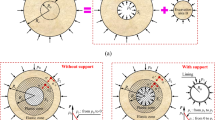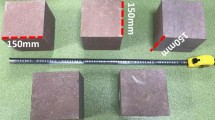Abstract
The deformational behavior of jointed rock masses is greatly influenced by the geometrical and mechanical characteristics of joints. Shear (ks) and normal (kn) stiffness of joints not only are vital input factors in the dis-continuum numerical analysis but also use to calculate elastic constants of an equivalent continuous material in the finite element numerical modeling. In this study, based on eighty-nine laboratory direct shear tests under constant normal loading (CNL) conditions, the dependency of ks and kn on normal stress (σn) is evaluated by the regression models. All natural and saw-cut discontinuity specimens belong to the meta-sandstone and limestone rock types. The range of the normal stress and ratio of normal stress to joint compressive strength was from 0.34 to 7.5 MPa and 0.01 to 0.24, respectively. The data analysis led to the inevitable outcome; the ks and kn versus σn increased by the power-law and exponential-law relationship, respectively. The shear stiffness not only in a natural joint, in which joint roughness coefficient (JRC) has a direct effect on the stiffness but also in a saw-cut specimens shows a power-law relationship with normal stress. Besides, the normal to shear stiffness ratio (\( \raisebox{1ex}{${k}_n$}\!\left/ \!\raisebox{-1ex}{${k}_s$}\right. \)) against the σn exhibit a non-linear trend line; the meta-sandstone bedding and joint show the power and the exponential trend line, respectively; the stiffness ratio (\( \raisebox{1ex}{${k}_n$}\!\left/ \!\raisebox{-1ex}{${k}_s$}\right. \)) at lower normal stress (0.5 MPa) were from 1.5 to 5.6, but by increasing the σn up to 7.5 MPa the stiffness ratio raised to 14.4. Considering the effect of normal stress on joint stiffness while choosing the reliable input factors for numerical analysis can avoid conservative analysis.









Similar content being viewed by others
References
Amadei B (1983) Brebbia C A, Orszag S A (eds) Rock anisotropy and the theory of stress measurements, Lecture Notes in Engineering. Springer-Verlag, Berlin
Amadei B, Savage WZ (1993) Effect of joints on rock mass strength and deformability. In: Hudson JA (ed) Comprehensive Rock Engineering—Principle, Practice and Projects, Pergamon, vol 1. Oxford, UK, pp 331–365
ASTM D5607–08(2008) Standard test method for performing laboratory direct shear strength tests of rock specimens under constant normal force
Bandis SC (1990) Mechanical properties of rock joints. In International symposium on rock joints, pp 125-140
Bandis SC, Lumsden AC, Barton NR (1983, December) Fundamentals of rock joint deformation. Int J Rock Mech Min Sci Geomech Abstr 20(6):249–268
Barla G, Barla M, Martinotti ME (2010) Development of a new direct shear testing apparatus. Rock Mech Rock Eng 43:117–122
Barton N (1973) Review of a new shear-strength criterion for rock joints. Eng Geol 7(4):287–332
Barton N, Choubey V (1977) The shear strength of rock joints in theory and practice. Rock Mech 10(1):1–54
Barton N, Bandis S (1980) Technical note: some effects of scale on the shear strength of joints. Int J Rock Mech Min Sci 17:69–73
Blümel, Pötsch (2003) Direct shear testing system. Geotechnical Measurements and modelling. In: Natau O, Fecker E, Pimentel E (eds) Karlsruhe, Germany, Swets and Zeitlinger, Lisse, pp 327–332
Boulon M (1995) A 3D direct shear device for testing the mechanical behaviour and the hydraulic conductivity of rock joints. In: Second Int Conference on Mechanics of Jointed and Faulted Rock MJFR-2, Vienna, Balkema, Rotterdam, pp 407–413
Brown SR (1987) A note on the description of surface roughness using fractal dimension. Geophys Res Lett 14(11):1095–1098
Fossum AF (1985) Effective elastic properties for a randomly jointed rock mass. Int J Rock Mech Min Sci Geomech Abstr 22:467–470
Gerrard CM (1982a) Elastic models of rock masses having one, two and three sets of joints. Int J Rock Mech Min Sci Geomech Abstr 19:15–23
Gerrard CM (1982b) Joint compliances as a basis for rock mass properties and the design of supports. Int J Rock Mech Min Sci Geomech Abstr 19:285–305
Gerrard CM (1991) The equivalent elastic properties of stratified and jointed rock masses. In: Beer G, Brooker, J R, Carter J P (eds.) Proceedings of international conference on computer methods and advances in geomechanics, cairns. Balkema, Rotterdam, pp 333–337
Goodman RE, Taylor RL, Brekke TL (1968) A model for the mechanics of jointed rock. J Soil Mech Found Div 94(3):637–659
Goodman RE (1989) Introduction to rock mechanics, vol 2. Wiley, New York
Infanti N, Kanji MA (1978) In situ shear strength, normal and shear stiffness determinations at Agua Vermelha Project. Proceeding of 3rd International congress of IAEG. Madrid 2:175–183
Jiang Y, Xiao J, Tanabashi Y, Mizokami T (2004) Development of an automated servo-controlled direct shear apparatus applying a constant normal stiffness condition. Int J Rock Mech Min Sci 41(2):275–286
Johansson F, Stille H (2014) A conceptual model for the peak shear strength of fresh and un-weathered rock joints. Int J Rock Mech Min Sci 69:31–38
John K W (1970) Civil engineering approach to evaluate strength and deformability of regularly jointed rock. Proceeding of llth Symposium on Rock Mechanics, pp 68-82
Kulhawy FH (1978) Geomechanical model for rock foundation settlement. J Geotech Eng 104(2):211–227
Ladanyi B, Archambault G (1969, January) Simulation of shear behavior of a jointed rock mass. In The 11th US Symposium on Rock Mechanics (USRMS). American Rock Mechanics Association
Malinverno A (1990) A simple method to estimate the fractal dimension of a self‐affine series. Geophys Res Lett 17(11):1953-1956
Muralha J, Grasselli G, Tatone B, Blümel M, Chryssanthakis P, Yujing J (2014) ISRM suggested method for laboratory determination of the shear strength of rock joints: revised version. Rock Mech Rock Eng 47(1):291–302
Oda M, Suzuki K, Maeshibu T (1984) Elastic compliance for rock-like materials with random cracks. Soils Found. Tokyo, Japan 24:27–40
Oda M (1988) An experimental study of the elasticity of mylonite rock with random cracks. Int J Rock Mech Min Sci Geomech Abstr 25:59–69
Patton FD (1966) Multiple modes of shear failure in rock 1st ISRM Congress. International Society for Rock Mechanics and Rock Engineering, Lisbon
Priest SD (1993) Discontinuity analysis for rock engineering, 1st edn. Chapman & Hall, London
Rosso RS (1976) A comparison of joint stiffness measurements in direct shear, triaxial compression and in situ. Int J Rock Mech Min Sci Geomech Abstr 13:167–172
Ríos-Bayona F, Johansson F, Mas-Ivars D (2021) Prediction of peak shear strength of natural, unfilled rock joints accounting for matedness based on measured aperture. Rock Mech Rock Eng, 1-18
Singh B (1973) Continuum characterization of jointed rock masses, part I—the constitutive equations. Int J Rock Mech Min Sci Geomech Abstr 10:311–335
Thirukumaran S, Indraratna B (2016) A review of shear strength models for rock joints subjected to constant normal stiffness. J Rock Mech Geotech Eng 8(3):405–414
Xie S, Lin H, Chen Y, Yong R, Xiong W, Du S (2020) A damage constitutive model for shear behavior of joints based on determination of the yield point. Int J Rock Mech Min Sci 128:104269
Yoshinaka R, Yambe T (1986) Joint stiffness and the deformation behavior of discontinuous rock. Int J Rock Mech Min Sci Geomech Abstr 23:19–28
Zhang L (2010) Method for estimating the deformability of heavily jointed rock masses. J Geotech Geoenviron 136(9):1242–1250
Zhang L (2016) Engineering properties of rocks. Butterworth-Heinemann
Acknowledgments
The authors would like to show their gratitude to the Iran Water and Power Resources Development Company (IWPC) and Mahab Ghodss Consulting Engineering Company for using geo-mechanical data of the mentioned hydropower projects.
Author information
Authors and Affiliations
Corresponding author
Ethics declarations
Conflict of interest
The authors declare that they have no competing interests.
Additional information
Responsible Editor: Zeynal Abiddin Erguler
Rights and permissions
About this article
Cite this article
Shahverdiloo, M.R., Zare, S. Studying the normal stress influential factor on rock joint stiffness using CNL direct shear test. Arab J Geosci 14, 2082 (2021). https://doi.org/10.1007/s12517-021-08449-6
Received:
Accepted:
Published:
DOI: https://doi.org/10.1007/s12517-021-08449-6




